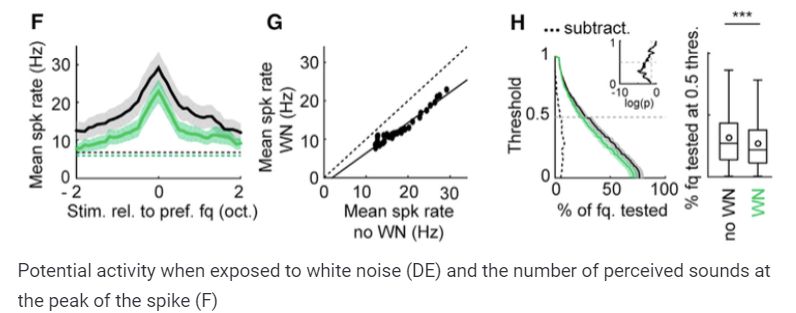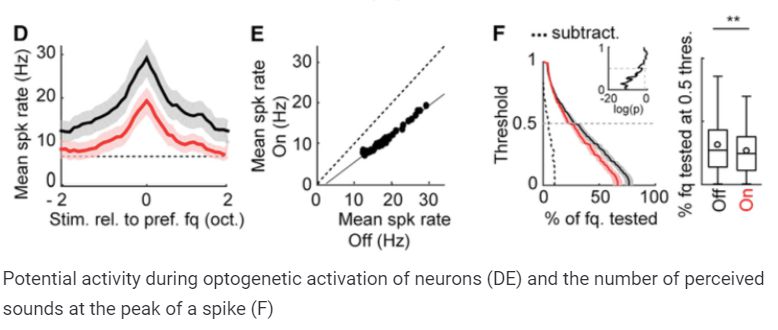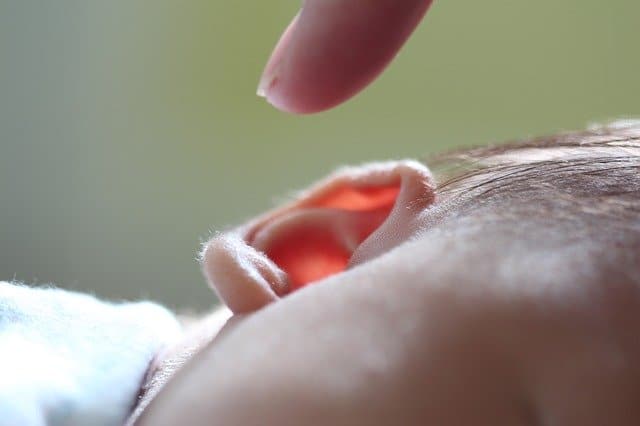White noise against the background of sounds helps to distinguish them more effectively from each other by limiting the activity of the auditory cortex neurons. This was found out by Swiss scientists who studied the brain activity of mice when listening to sounds. The effect was significant for sounds with spectrally close frequencies (i.e. virtually non-different from each other), and also manifested behaviorally. In addition, similar changes were observed in the optogenetic activation of neurons involved in the regulation of auditory perception. This indicates the adaptability of the auditory system of the brain in the face of noise pollution that affects stimulation.
The activity of different parts of the sensory cortex of the brain is quite specific: areas that are involved in the processing of information obtained through different modalities are activated only under the influence of certain stimulation on the receiving channels (for example, light received through the retina of the eye, or sound that the hair cells of the ear perceive ) Interestingly, this specificity also manifests itself within the perception of a certain modality: in other words, for certain sections of the sensory system, the parameters of the incoming signal are very important.
For example, neurons of the auditory cortex selectively process sounds depending on their frequency. At the same time, they are quite adaptive and amenable, for example, to background noise or sudden changes in sound that attract the attention of the listener. However, little is known about how such adaptability affects auditory perception and subsequent regulation of behaviour.
To study this question in more detail, Rasmus Christensen from the University of Basel and his colleagues decided to conduct an experiment on mice. To do this, they included 37 experimental sounds of different frequencies (from 4 Hertz from 48.7 Kilohertz) for a duration of 50 milliseconds each at a volume level of 60 decibels. Sounds were turned on either clean or in the background, “white” noise with a volume level just below the stimulus (50 decibels). Brain activity in the perception of sounds was measured using electrodes implanted in the brain of mice, then obtaining a function of the dependence of the action potential of neurons of the primary auditory cortex on the frequency of the sound played.
Scientists found that the presence of white noise in the background of the sound being played causes a decrease in the magnitude of the spikes (potential fluctuations when a neuron is excited): by 14.2% before the start and by 26.1% during peak activity. A similar change was observed in all selectively activated areas of the primary auditory cortex, regardless of the frequency characteristics of the stimulus. It also turned out that the number of sound frequencies whose perception occurs with the spike at the peak threshold is significantly (p = 0.0004) lower in the presence of white noise than without it. This, in turn, suggests that the selectivity of the primary auditory cortex is higher with noise, while the noise itself does not affect the perception.

To test how a decrease in the response of the auditory cortex in response to sound stimulation in the presence of noise affects the behavioural aspects of auditory perception, scientists conducted an experiment using the experimental go / no go paradigm. In it, they trained mice to receive refreshments (droplets of milk) in response to a sound of a certain frequency and punishment (airflow) in response to sounds of other frequencies when licking a special tube. An analysis of the data showed that the use of white noise in sound stimulation improves the recognition of sounds that are spectrally nearby: for example, using noise, mice more effectively distinguish sounds that differ from each other by 0.35 (p = 0.002) and 0.2 octaves ( p = 0.001).
To study the detailed mechanism of the influence of white noise on the activity of neurons of the auditory cortex, scientists then turned to methods of optogenetics — selective activation of neurons by means of exposure to light-sensitive opsins introduced into the membrane. Researchers introduced activating canalrodopsin (ChR2) into parvalbumin – containing plug-in neurons that regulate signal transmission in the sensory systems of the brain. It turned out that the selective activation of such neurons leads to the same result as the use of white noise: the size of spikes decreases by 18.8% before the start and by 35.6% during peak activity. Just as when using noise, a significant (p = 0.0014) decrease in the number of frequencies perceived at the peak spike threshold was observed.

The optogenetic activation of parvalbumin-containing neurons has also improved auditory discrimination. The results were similar to those obtained using white noise: the distinction of sounds, differing by 0.35 octaves (p = 0.021) and 0.2 octaves (p = 0.008), also improved.
As for specific areas of the brain that are involved in the regulation of perception under the influence of white noise and optogenetic activation, scientists also noted the work of the cranked body of the thalamus, which is also involved in the processing of auditory information. The effect, however, was not as pronounced as that observed with the auditory cortex.
The authors concluded that a change in the activity of the auditory cortex (using either white noise or optogenetic activation) changes auditory perception, improving it – and this effect also manifests itself behaviorally. A possible explanation for this effect is the selective discrimination of frequencies by individual neurons of the auditory cortex compared with the usual spontaneous activity in the case when additional stimulation does not need to be screened out. From this, in turn, we can conclude that the sensory systems of the brain (at least auditory) are better adapted to perceive information at a certain level of additional noise, which is understandable: significant sounds against the background of absolute silence are more unusual for perception.
